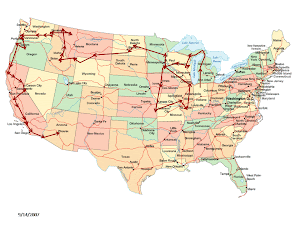 While eating at the "Wet Dog", we saw this tug pulling the barge.
While eating at the "Wet Dog", we saw this tug pulling the barge. This boat passed by while we were eating. There is a bar pilot's boat alongside.
This boat passed by while we were eating. There is a bar pilot's boat alongside. This is the Coast Guard boat display.
This is the Coast Guard boat display.Today we went to the Columbia River Maritime Museum. This was definitely worth the time. It explains the dangerous Columbia River Bars. The Columbia River opening to the Pacific is 4 miles wide. This is where the ocean water meets the powerful river water that has been collecting for over 1200 miles. At this point several things happen. Much silt is deposited from the river and the two currents rushing together make a whitewater display that can even the biggest ocean liners to sink. Couple this with stormy ocean conditions with 70 mile per hour winds and it is very, very dangerous. The waves can be 40 to 70 feet high and can crash over the ships. When we went by the bars, they were low, but I wouldn’t have wanted to go through them. They made the level 4 rapids we went through on the Snake River a few weeks ago look like child’s play. I posted earlier today about the bar pilots and their important role in guiding the ships through the river bar. I wondered why they didn’t just plot a course and put it in a GPS and then they wouldn’t have to have the Bar Pilots. At the museum I found out the reason why this wouldn’t work – the bars move. This means the danger is always moving as the bar changes location. Couple this with the tide coming in and going out and you have a very complicated situation. At the museum they showed bar pilots boarding the boats and the techniques they use. It was very interesting.
The Columbia is the largest river (measured by volume) flowing into the Pacific from the Western Hemisphere, and is the fourth-largest in North America, behind the Mississippi, St. Lawrence, and Mackenzie Rivers. (In rare years, the river’s flow may actually exceed that of the Mississippi.) The Columbia's average annual flow is about 265,000 ft/second. It flows 1,243 miles from its headwaters to the Pacific, draining 258,000 square miles, of which about 15% is in Canada.
The Columbia is the largest river (measured by volume) flowing into the Pacific from the Western Hemisphere, and is the fourth-largest in North America, behind the Mississippi, St. Lawrence, and Mackenzie Rivers. (In rare years, the river’s flow may actually exceed that of the Mississippi.) The Columbia's average annual flow is about 265,000 ft/second. It flows 1,243 miles from its headwaters to the Pacific, draining 258,000 square miles, of which about 15% is in Canada.
The Columbia Bar is a bar at the mouth of the Columbia River between the U.S. states of Oregon and Washington. The river's current often dissipates into the Pacific Ocean as large, standing waves, partially caused by the deposition of sediment as the river slows. These standing waves are usually mixed with ocean waves and wreak havoc with vessels of all sizes. The Columbia current varies from 4 to 7 knots westward and therefore into the predominantly westerly winds and ocean swells, creating significant surface conditions. Unlike other major rivers, the current is focused "like a fire hose" without the benefit of a river delta. Conditions can change from calm and serene to life-threatening breaking waves in as little as five minutes due to changes of direction of wind and ocean swell. Since 1792, approximately 2,000 large ships have sunk in and around the Columbia Bar.
The nearby United States Coast Guard station at Cape Disappointment, Washington is renowned for operating in some of the roughest sea conditions in the world and is also home to the National Motor Lifeboat School. It is the only school for rough weather and surf rescue operation in the United States and is respected internationally as a center of excellence for heavy boat operations.
Bar pilots consider "the bar" to be the area between the north and south jetties and Sand Island.
The Columbia Bar is part of a set of major marine coastal hazards along the Pacific Northwest coast, including Cape Flattery at the northwest tip of the Olympic Peninsula and Cape Scott, which is at the north tip of Vancouver Island. Historically this region's nickname to mariners was the Graveyard of the Pacific, and the region is studded with thousands of shipwrecks.
The Coast Guard display was very good and it told how difficult their training is. They actually had a retired boat on display. The retired boat had rolled over in the bar several times and even went end over end once. There was a time when a huge boat lost its rudder and crashed into the dock where the coast guard boat was tied. The boat was gone and it was thought that it was crushed. When they pulled the big boat away, the coast guard boat bobbed to the top and was still usable.


No comments:
Post a Comment